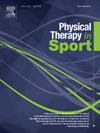Effectiveness of adding Dynamic Tape® to progressive tendon-load exercise program in patients with patellar tendinopathy: A randomized controlled trial
IF 2.2
3区 医学
Q1 REHABILITATION
引用次数: 0
Abstract
Objective
To evaluate the effectiveness of adding Dynamic Tape® to a progressive load exercise program in patients with patellar tendinopathy.
Design
Randomized controlled trial.
Setting
University research.
Participants
Forty-eight subjects with patellar tendinopathy.
Methods
Participants were divided into two groups: dynamic group, which received progressive load exercises and Dynamic Tape®, and sham group, which received progressive load exercises and sham taping. The intervention was conducted three times per week over 12 weeks.
Main outcome measures
The pain during decline squatting was assessed using a visual analog scale. The severity of patellar tendinopathy was measured using the Victorian Institute of Sport Assessment-Patella (VISA-P).
Results
There was no effect of group-time interaction for the pain (Z = 0.844, p = 0.472) or severity (Z = 1.275, p = 0.286) of patellar tendinopathy. Reduced pain and severity were observed over time (p < 0.05), however there was no between-group differences (p > 0.05).
Conclusion
Dynamic Tape® does not provide additional benefits when combined with a progressive load exercise program for reducing pain and severity in patellar tendinopathy.
动态胶带®加入进行性肌腱负荷锻炼计划对髌骨肌腱病变患者的有效性:一项随机对照试验。
目的:评价在进行性负荷运动中加入Dynamic Tape®对髌骨肌腱病变患者的疗效。设计:随机对照试验。环境:大学研究。参与者:48名髌骨肌腱病变患者。方法:参与者分为两组:动态组,接受渐进式负荷练习和dynamic Tape®;假手术组,接受渐进式负荷练习和假手术胶带。干预每周进行三次,持续12周。主要结果测量:用视觉模拟量表评估蹲下时的疼痛。髌骨肌腱病变的严重程度采用维多利亚运动评估-髌骨研究所(VISA-P)进行测量。结果:组间交互作用对髌骨肌腱病变疼痛程度(Z = 0.844, p = 0.472)和严重程度(Z = 1.275, p = 0.286)无影响。随着时间的推移,疼痛和严重程度有所减轻(p < 0.05)。结论:Dynamic Tape®与渐进式负荷运动项目联合使用时,对于减轻髌骨肌腱病变的疼痛和严重程度没有额外的益处。
本文章由计算机程序翻译,如有差异,请以英文原文为准。
求助全文
约1分钟内获得全文
求助全文
来源期刊

Physical Therapy in Sport
医学-康复医学
CiteScore
4.50
自引率
8.30%
发文量
125
审稿时长
39 days
期刊介绍:
Physical Therapy in Sport is an international peer-reviewed journal that provides a forum for the publication of research and clinical practice material relevant to the healthcare professions involved in sports and exercise medicine, and rehabilitation. The journal publishes material that is indispensable for day-to-day practice and continuing professional development. Physical Therapy in Sport covers topics dealing with the diagnosis, treatment, and prevention of injuries, as well as more general areas of sports and exercise medicine and related sports science.
The journal publishes original research, case studies, reviews, masterclasses, papers on clinical approaches, and book reviews, as well as occasional reports from conferences. Papers are double-blind peer-reviewed by our international advisory board and other international experts, and submissions from a broad range of disciplines are actively encouraged.
 求助内容:
求助内容: 应助结果提醒方式:
应助结果提醒方式:


